CABLES VS. FREE WEIGHTS: 7 EXERCISES WHERE CABLES ARE SUPERIOR
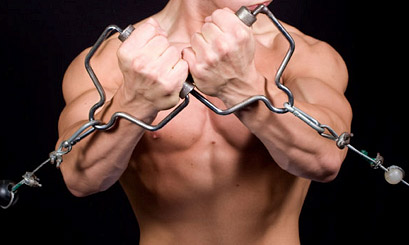
All right, guys, it’s showdown time. Cables vs. free weights…which one is better for building muscle?
While it’s true that basic barbells and dumbbells should form the cornerstone of your overall training plan for their high degree of muscle building effectiveness and versatility, they still do have certain drawbacks depending on the specific lift you’re performing.
In particular, this applies to any exercise where the resistance is lifted in a circular movement pattern rather than in a straight line.
Since free weights rely solely on the straight-up-and-down force of gravity for each exercise, circular movements will always end up producing an inconsistent resistance curve where there is either a high degree of tension in the bottom half of the range of motion and very little at the top, or a high degree of tension in the top half with very little in the bottom.
In order to maximize the stress on any given muscle and achieve the strongest growth-producing stimulus possible, the goal should be to place that muscle under consistent tension throughout the entire range of motion from top to bottom.
This is a situation where cables allow you to do something that simply can’t be replicated using free weights. They enable you to place the resistance in the proper line in order for consistent tension to be produced.
Below, I’m going to outline 7 common muscle building exercises that are simply better suited to a cable variation for this reason.
Now don’t get me wrong here – the basic free weight versions of these lifts are all still highly effective. I’m not implying that you have to eliminate them from your plan or that you MUST use cables in order to get great results.
Treating the issue of cables vs. free weights as being “one or the other” simply isn’t necessary, and you can just use a mixture of both if you prefer.
However, if you do have access to cables and want to fully optimize your muscle building results, here are 7 exercises that I’d recommend including in your routine, either in place of the free weight variations or alongside them…
Exercise #1: Chest Flys
Chest flys performed at either a flat, incline, or decline angle are a great follow-up to your compound pressing exercises as a way of directly isolating the pecs with minimal involvement of the triceps. A few sets of flys performed at the end of your chest workout is a great way to round out your routine for maximum pec stimulation.
The downside of traditional dumbbell flys is that they only place the pecs under a high degree of tension in the bottom half of the range of motion. As you come up past halfway and into the fully contracted position, the tension is minimized since gravity is simply pulling the resistance straight up and down.
Since the primary function of the pecs is to bring the upper arm across the front of the body (known as “horizontal adduction”), flys are best executed when the resistance is pulling your arms out to the sides so that the chest is actively working through this exact function throughout the entire range of motion.
For that reason, your best bet here is going to be a cable fly, either performed lying on a bench in between a cable stand or done from a standing position.
(I’ve also included these in my best exercises for the lower chest.)
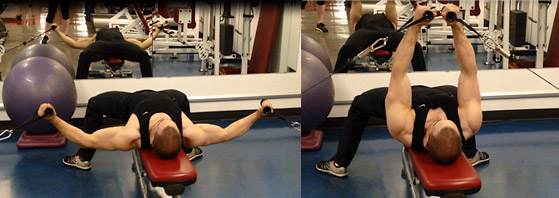
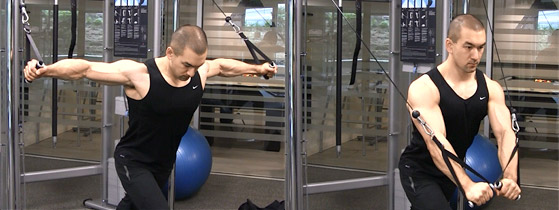
You can angle the bench at an incline, flat, or decline angle to emphasize the upper, middle, or lower chest respectively. Or, if you’re performing them standing, you can pull from low to high, straight across, or high to low to target those same three regions of the pecs.
Cable flys place the pecs under constant tension from the fully stretched position all the way to the fully contracted position and will therefore be a slightly more effective variation in comparison to using dumbbells if your goal is to maximize hypertrophy.
Exercise #2: Side Lateral Raises
Side lateral raises are the single most valuable exercise in your arsenal when it comes to building round, thick shoulders that really stand out. This is because they directly isolate the lateral head of the deltoid, which is that meaty portion on the side of the shoulder that gives your upper body that “wide” look.
The most common variation for these is the standard dumbbell side lateral raise, either performed from a standing or seated position. While these still do allow you to effectively train the lateral head of the shoulder, the disadvantage of using dumbbells is the lack of tension that is produced in the bottom half of the range of motion.
As you stand with the dumbbells at your sides there’s virtually no stress on the shoulders at all, and it’s only when you come up past halfway that they really kick into gear. As with the chest fly, the only way to solve this is by having the resistance pulling your arms from the side rather than using the straight-up-and-down force of gravity.
To do this, you’ll want to go with a cable side lateral, ideally performed one arm at a time. You should really feel the difference with this variation, as the lateral head of your shoulder will be under constant tension from the bottom position all the way to the top.
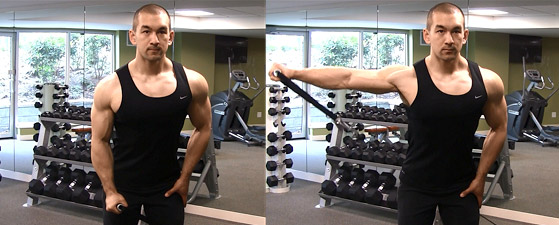
Most lifters also find the cable side lateral raise to be easier on the shoulder joints in comparison to using dumbbells, which is a great added benefit.
Exercise #3: Rear Lateral Raises
Don’t forget your rear delts.
The cable rear lateral raises are executed using the same basic motion as the side lateral raise, except that your body will be in a bent over position and you’ll be targeting the posterior head of the shoulder (the rear) as opposed to the lateral head.
The same logic applies here: when performing rear laterals using dumbbells like most people do, the posterior head of the shoulder is only significantly activated in the top half of the movement, with very little to no tension in the bottom half.
Once again, you can ramp up the effectiveness of this movement by going with a bent over rear lateral cable raise performed one arm at a time.
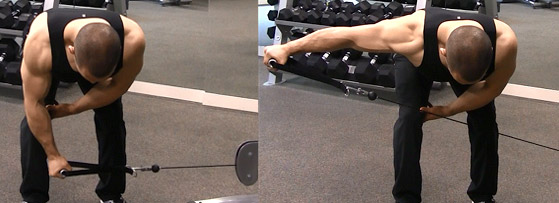
Another effective variation that you can test out as well is to do these in a standing position in between a cable stand, directly gripping the cables without any attachments and using a “reverse fly” motion.
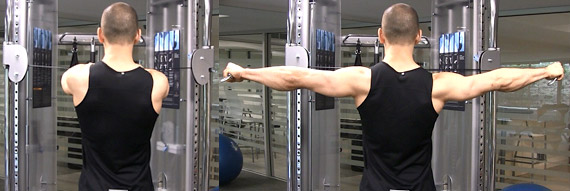
Exercise #4: Straight-Bar Bicep Curls
Although the basic barbell curl has always been treated as the “bread and butter” of direct bicep training, take a look at the actual mechanics of the movement and you’ll see that it’s actually not the ideal way to place the biceps under maximum tension.
This is due, once again, to the straight up and down direction that gravity pulls the bar. Although the biceps are hit very hard in the middle to top half of the exercise, the tension greatly decreases in the bottom half, with very little tension on the biceps in the fully lengthened position as you stand with the bar against your thighs.
The barbell curl is still an effective movement overall, but if you want to fully stress your biceps throughout the entire curling motion, a cable curl is the way to go.
To do this, grab a single cable pulley attachment, stand facing away from the weight stack, and then perform your cable curls one arm at a time. This way, the weight will be pulling your arm down and back, forcing your biceps to be constantly engaged not only at the very top of the curling movement but also in the very bottom as well.
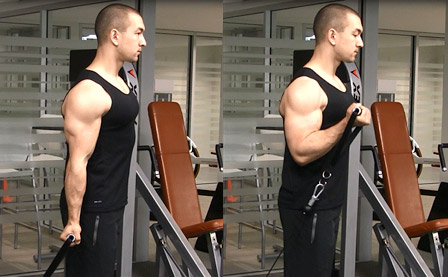
Compare this to a standard barbell curl and you should definitely notice an increase in overall bicep stimulation.
Exercise #5: Tricep Extensions
When it comes to tricep extensions, the free weight variations with straight bars or dumbbells typically present the opposite problem that free weight bicep curls do: the triceps will be fully engaged in the bottom half of the movement, but the tension will gradually decrease as the weight is extended upward into the fully extended position.
So once again, in order to keep full stress on the triceps at all times throughout the movement by having the resistance pulling both down and back, you’ll ideally want to perform your extension exercises using cables.
For overhead extensions: Place the cable at the very bottom of the machine and then stand facing in the opposite direction, directly grabbing onto the cable without any attachments. From there, simply perform a standard overhead extension by pressing your hand directly overhead.
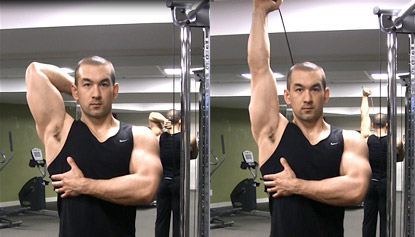
For skull crushers: Place a bench a couple feet away from a cable stand and attach a straight-bar, ez-curl bar, or rope to the bottom of the machine. From there, just perform your skull crushers as you normally would.
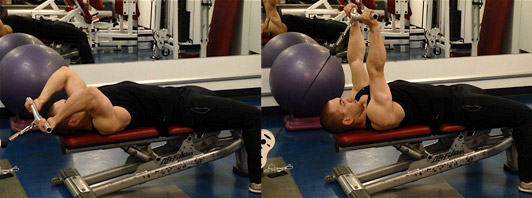
For kickbacks: Place the cable at the very bottom of the machine and then perform your kickbacks as normal in a bent over position. You can either grab one side of a rope attachment here or just grab right onto the cable itself.
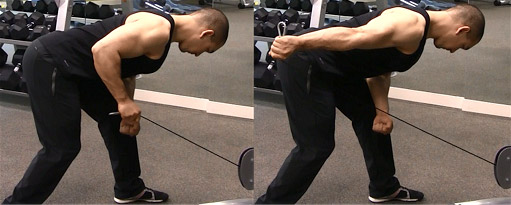
Exercise #6: Pullovers
Although these aren’t a very common exercise that you’ll see in the gym, cable pullovers actually a great way to directly isolate the lats through a large range of motion and without involving the biceps like most other traditional compound back exercises do.
The most common way that you’ll see these being done is by laying perpendicular across a flat bench and then performing the movement using a single dumbbell. But as with all other circular free weight exercises, this variation simply doesn’t allow you to place the targeted muscle under constant tension all the way through.
In this case, you end up with significant stress on the lats in the bottom half of the movement, with the stress being increasingly reduced the further and further you pull the dumbbell toward your chest. At the very top when the dumbbell is hanging directly over your chest, the lats are almost completely disengaged.
The way to go about tackling this one is to perform cable pullovers in a standing position facing the machine.
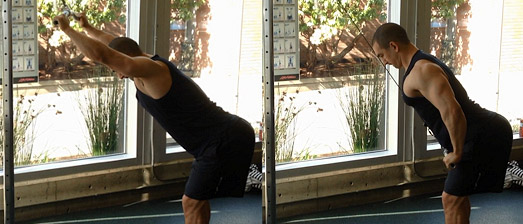
Take a look at the specific motion being used and the direction that the resistance is pulling in, and you’ll see that the lats are now being placed under continual tension from start to finish.
Exercise #7: Weighted Crunches
If you really want to target the rectus abdominis and build up your “six pack” muscles effectively, you need to be including some type of spinal flexion exercise in your plan as this is the primary function that these muscles perform.
Performing standard weighted crunches on the floor, a decline bench or a swiss ball are all useful ways of accomplishing this that do work well, however, to hit your abs as intensely as possible, cable crunches are going to be your best choice.
The reason for this is exactly the same as everything we’ve discussed so far: because the motion is done in a circular fashion, you’ll simply be unable to maintain full tension on the abdominal muscles all the way through while still using the full range of motion that they’re capable of.
A kneeling rope crunch, on the other hand, does allow you to accomplish this. Attach the rope at the top of the machine, get down into a kneeling position with your hands on either side of your head, blow the air out of your lungs, flex your abs hard and then crunch down until your elbows touch the floor.
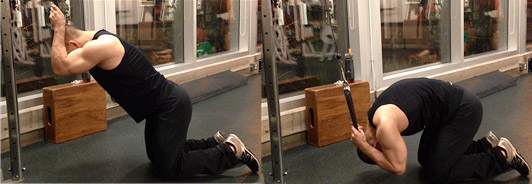
You’ll need to play around a bit to find the best position for yourself here, but when done properly, you should feel a very deep contraction in your abdominal muscles that you don’t get from other traditional crunching exercises.
Cables Vs. Free Weights: Quick Recap
So, if your goal is to achieve maximum hypertrophy and place your muscles under as much tension as possible on each exercise you perform in the gym, these are the 7 common free weight exercises that are actually best performed using cables:
#1: Dumbbell Flys –> Cable Flys (lying or standing)
#2: Dumbbell Side Laterals –> One-Arm Standing Cable Side Laterals
#3: Bent Over Dumbbell Rear Laterals –> One-Arm Bent Over Cable Rear Laterals OR Standing Reverse Cable Flys
#4: Straight-Bar Curls –> One-Arm Cable Curls
#5: Tricep Extensions –> Overhead Cable Extensions / Lying Cable Skull Crushers / Cable Kickbacks
#6: Dumbbell Pullovers –> Standing Cable Pullovers
#7: Weighted Crunches –> Rope Crunches
If you’ve been exclusively performing any of these lifts using free weights only, give these cable variations a try and you should notice a definite improvement.
If you found this article helpful, make sure to sign up for your FREE custom fitness plan below...




